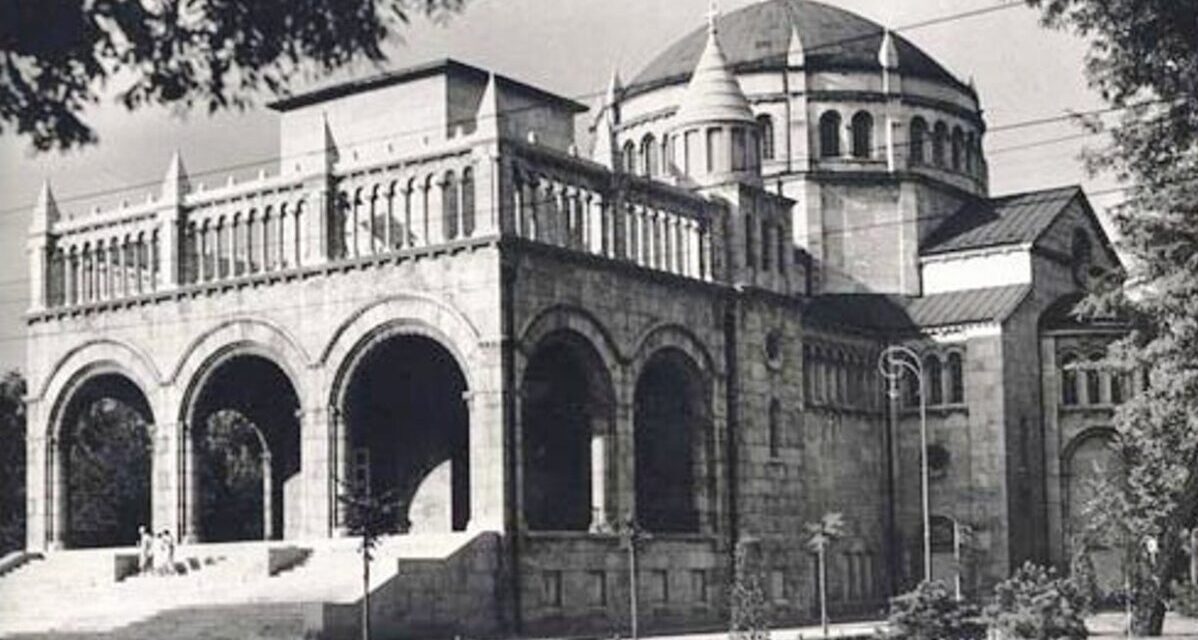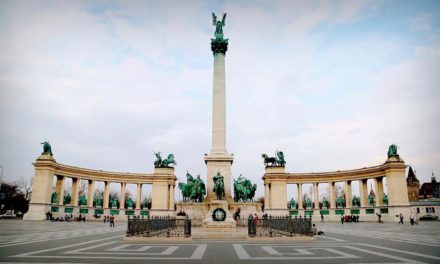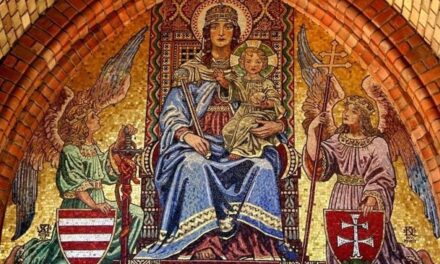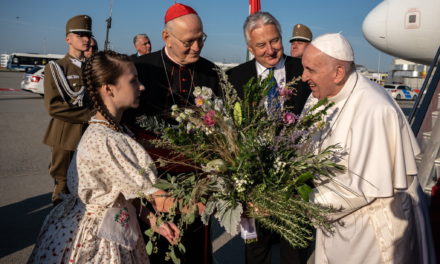Regnum Marianum, which adorns the mezgye of Városliget, was blown up 73 years ago. The communist government was aware of the spirituality of the place, so in 1969 a statue was erected in memory of the Soviet Republic right here, on the site of the church of thanksgiving over the fall of the Soviet Republic.
While it was standing, the Regnum Marianum on the edge of Liget was reminiscent of the Sacré Coeur in Paris, although the plans were dreamed up by Iván Kotsis, professor of modern construction technology at the University of Pest, with a Hungarian heart and planted in Hungarian soil. For the dome of the church, for example, he took the shape and scale of the Holy Crown as a model.
In other respects, the 1,820-square-meter, domed, basilica-like house of worship in Budapest was more similar to the Church of the Holy Sepulcher in Jerusalem than to the Sacré Coeur in Paris, although it is undoubtedly related to the latter.
For example, they had a common fate, as both the Regnum Marianum and the Sacré Coeur in Paris were built after the fall of the blood-red left-wing terror representing anti-church principles. The Parisian commune, and the Regnum Marianum after the fall of the council republic here - both out of gratitude.
According to the founding document of Regnum Marianum drawn up in 1922:
"Let's build this church to permanently remind everyone of the horrors of the Red Terror, which were inflicted on us by the forgotten disloyalty, selfishness and hatred of our church."
Regnum's official name is Magna Domina Hungarorum, meaning the Great Lady of the Hungarians. It got its popular name from the organization of the Regnum Fathers who initiated the construction, which was established in 1896 on the initiative of nine religious teachers as a community of diocesan secular priests and religious teachers in Damjanich Street, which was considered the outskirts of the capital at the time.
Measured on a historical scale, Budapest developed into a metropolis of millions in an instant. Thousands of people migrated from the countryside to the capital, settling in the working-class districts of Pest, and partially shedding their religious past as one of the thousands of memories of their old village life. The church was unable to react to this rapid change, so at the turn of the previous century, the capital became thoroughly secularized, with only nine parishes operating. However, these were huge parishes, for example one hundred thousand believers belonged to the parishes.
Ottokár Prohászka - who later became the bishop of Székesfehérvár, but at that time still taught the minor priests as a spiritual teacher of the Esztergom Seminary - significantly supported the VI. the community organized in Damjanich Street in the district, which tried to implement his principles of religious education, which can still be said to be modern today.
He wrote this in 1912: "It was a long time ago when I wrote a piece in the newspaper about that particular acacia tree on Damjanich Street, which sinks its roots into the sand of the city park and extends its branches not only to the end of the capital city, but to many, many streets, somehow to the whole of Hungary. This acacia tree is the Regnum Marianum Institute.”
In 1919, the Esztergom Archdiocese Authority separated from the Erzsébetváros parish and established the parish of Our Lady of Magyars, which temporarily operated at Damjanich utca 50, but its parish priest, Shovy Lajos, established the Church Building Committee as early as 1921 and the parish and regnum were clearly separated community.
It should be known about Lajos Shovy that he was a student of Ottokár Prohászka at the Esztergom Seminary. He was ordained a priest on July 13, 1901.
He first became a study supervisor in the convent of the Regnum Marianum priestly community, then the director of the convent from 1905, and a religious teacher from 1910. He built a lot on the activity of the laity. Together with his companions, he introduced the principles of scouting in Hungary. He organized and led trips, walking and water tours for suburban proletarian children. He followed his master in everything, so it is no wonder that after Prohászka's death in 1927, XI. Pope Piusz appointed him the next bishop of Székesfehérvár.
After this detour, let's continue with the history of Regnum: the construction of the church began on the edge of Városliget, in the axis of Damjanich Street. The church was colloquially called Nagy Regnum, and Damjanich utca 50 was called Kis Regnum, and it remains so to this day.
The imposing Nagy Regnum was consecrated on July 14, 1931 by Prince Justinián Serédi. At that time, an ornate document was issued, which already reads: "This church was erected as a testimony of the revival of the Hungarian Catholic society, which was decimated by the World War, and which was torn apart in the collapse that did not recognize religion or nation."
Regnum Marianum, which was seriously damaged in the Second World War, was not only built but also destroyed by the communists. The imposing church was blown up on the orders of Mátyás Rákosi at the peak of the rampage of the personality cult.
According to the official justification, the wide space was needed for military parades and parades. In addition, they wanted to erect the Stalin statue here, next to the Regnum Marianum, the location of which was designated by János Kádár himself in April 1951. The later first secretary of the party led the committee that erected the Stalin statue at the time.
Regnum Marianum was barbarically destroyed on September 23, 1951: it was mined and then blown up.
However, the faithful, that is, the people of Budapest, did everything to save it. People surrounded him with life chains, to no avail. The armed men of the State Security Office, also referred to as the fist of the communists usurping power, arrested almost everyone and dragged them to Andrássy út 60. The church was destroyed in a barbaric manner, the sub-church was filled with the ruins, the rest was used to strengthen the embankment, but it also made its way into the plinth of the neighboring Stalin monument.
Three years later, on October 23, 1956, the statue of the Soviet dictator, weighing 203 masa, was toppled by the people of Pest.
In 1951, not only the church was destroyed by the authorities, but also the community of the Regnum Fathers was dissolved.
During the religious persecution, the priestly community continued to operate even without the church and headquarters, only now in illegality.
A good example of this is the regnum father István Keglevich, who died in 2000, who said the following in his interview book Prison Cross by Elmer István: "More than three hundred convicts were held in the strict prison in Mariano, all of them were enemies of popular democracy. More than a third of them are priests, the rest are religious civilians. An atheistic course was organized for the guards, so that they would not be converted by the prisoners. They treated us harshly. One of my fellow priests wrote down the text of Hiszekey, so he received ten days of strict confinement. The other was punished for singing the Ave Maria. On Good Friday, the refusal to eat meat was called a hunger strike, and the priests were once again punished for it (…) We, Regnumist priests, acted for the sake of justice, so they were powerless against us, and they also acknowledged this from time to time (…) I felt God’s great grace and inner spiritual joy throughout , and I still feel it today".
The communist government was aware of the spirituality of the place, so in 1969 a statue was erected in memory of the Soviet Republic on the site of the church of thanksgiving over the fall of the Soviet Republic.
The monument was erected on the last unexploded concrete pillar of Regnum. However, it is now in the sculpture museum, together with other monuments of the communist regime.
However, Mary's country is still alive, an existing reality. Or as Sándor Sík, the Piarist monk, wrote in his poem The Crown of Twelve Stars:
"This is the land, this is the landscape,
Where heaven and earth meet,
Where the Angel ascends and descends."
Cover image: The Regnum Marianum
Source: Original uploader was Jjdm at hu.wikipedia.Later version(s) were uploaded by Tambo at hu.wikipedia. – Transferred from hu.wikipedia; transfer was stated to be made by User:Tambo., CC BY-SA 3.0, https://commons.wikimedia.org/w/index.php?curid=18230659













